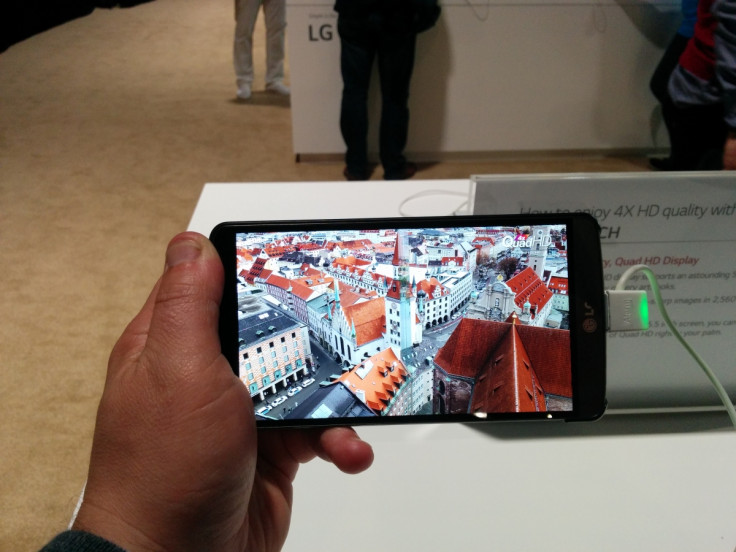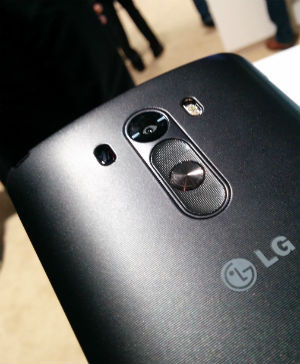LG G3 Hands-On Review – A Big, Bright, Plastic Monster

Key Features:
- 5.5in Quad HD Screen (2560 x 1440 pixels)
- Laser autofocus sensor
- Snapdragon 801 chip with 2GB RAM
- Redesigned interface
- UK Release Date: 1 July
- UK Price: Free on contracts of £38-a-month
LG has a challenge on its hands – and it's not one that higher pixel density or faster-than-a-blink-of-an-eye laser autofocus will solve.
LG launched its flagship smartphone, the G3, at a glitzy event in London on Tuesday evening, but after the launch, an executive confirmed to IBTimes UK that despite the cutting-edge technology featured in the G3, it will still struggle to compete at the high end of the smartphone market, especially in the UK where it currently has just over 3% of the market.
The challenge is to raise brand awareness so that customers (particularly in the UK) think about the LG brand in the same way they do about Apple and Samsung as well as lesser players like Sony and HTC.
The company's latest effort to bridge that divide it the LG G3:
Simple is the new smart
LG is pitching the G3 on how much simpler it will make your life.

To do this it is moving away from promoting the feeds and speeds which have dominated the smartphone landscape (at least the Android smartphone landscape) for years.
The problem with this approach is that all the headline features of LG's new phone are far from simple, and for most won't seem as if they are simplifying anything.
The first is that huge 5.5in screen with a 2560 x 1440 pixel resolution, giving it an eye-wateringly sharp pixel density of 538ppi. For comparison, Apple's iPhone 5s' 4in Retina display is 'just' 326ppi.
In reality the screen is initially hugely impressive. Bright, bold and vibrant with great colour reproduction. But trying to read text or focus on one detail within a photo made my eyes hurt. Maybe it was the lighting at the launch event, or maybe it was my eyes, but I didn't come away from looking at the screen thinking I want to read everything at 538ppi from now on.
LASERS!!!
The second big feature on the G3 is the laser-autofocus system which has previously only been available to owners of high end DSLR cameras. LG says the system can focus on your subject in under 300 milliseconds, which is how long it takes you to blink.
In a brief test, the system seemed to work excellently, with one tap on the screen focusing and capturing an image at the same time.

Whether this system works well (and as fast) in more challenging lighting conditions remains to be seen, but this at least is one feature which could make your life more simple.
Interface
LG has also overhauled the user interface on the G3, which again it says will simplify everything for the user. LG even goes as far as saying it has been on a "software diet" and that there are 30% less pre-installed apps on this version compared to the previoius interface.
There are some neat features - like Knock Code which lets you go from sleep to unlocked in one step - but diet or no diet the interface is still ugly and unintuitive, and most of the additional clutter LG imposes is superfluous.
LG told me the reason it and other manufacturers decide to skin the Android interface is to differentiate themselves from the competition.
If that's the case, then I have a tip for LG. Differentiate yourselves by NOT imposing a poorly designed, awkwardly implemented and annoying interface on your customers and use Google's very good and very reliable Android interface.
Design
Sticking a 5.5in screen on a smartphone will immediately put a lot of people off. The original phablet – the first Galaxy Note – featured a smaller 5.3in screen, meaning many people will think this phone will be just too big and unwieldy.
However, thanks to clever design and narrow bezels, LG has managed to keep the footprint of the phone down. The Sony Xperia Z2, which has a 5.2in screen, is slightly taller than the G3.
While LG has done its best to keep the footprint there is no getting away from the fact that this is a big phone, and will just be too big for many people. While bigger screen phones typically sell well in markets like South Korea and Japan, they have yet to become the norm here in the UK.

While the phone is big, it is lightweight at just 149g. this is 11g lighter than the HTC One M8 which has a much smaller screen.
The reason? LG has decided to continue its use of lightweight materials in the construction of its flagship phone, rather than the premium metal which HTC employs to such good effect.
Lg calls the construction mettalic but in the hand the phone is decidely plastic feeling, more akin to the Galaxy S5 than the HTC One or iPhone 5s.
The result is that for all its technical achievements, the G3 feels cheap and not very solid. This is a real shame as the phone's design is elegant and sleek, with the positioning of the power and volume buttons on the rear allowing the designers to create clean lines along the phone's edges.
Hard to judge
It's of course hard to judge a phone on a brief pawing at a launch event. Questions remain:
- Will the phone's battery cope with the increased screen size and pixel density?
- Will the phone's performance match the likes of the Galaxy S5 or Xperia Z2?
- Will the huge screen finally make watching a film on a smartphone acceptable?
All those questions will have to wait until I get my hands on a review unit in the coming weeks, but on first impressions, I don't think the LG G3 will move the dial enough for LG – at least not here in the UK.
© Copyright IBTimes 2025. All rights reserved.






















